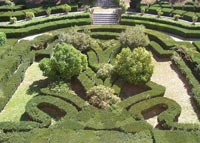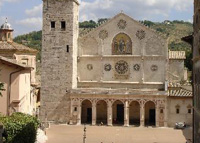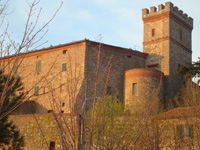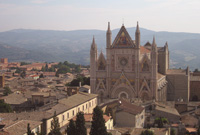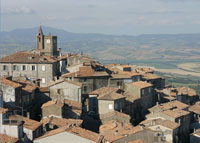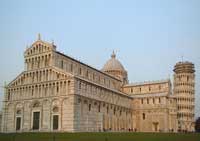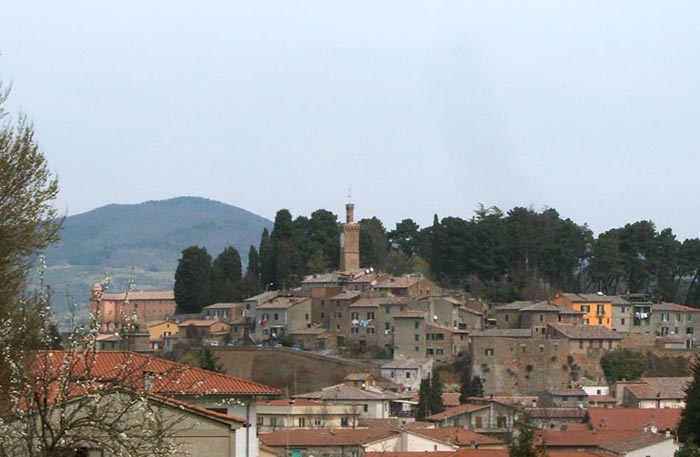 |
|
Acquapendente |
|
Acquapendente |
| The area of modern Acquapendente was settled by Etruscans and Roman times, as findings have showed. The name of the city, meaning Pending Water, stems from the presence of several small waterfalls forming the Paglia, a stream setting the boundary between Lazio and Tuscany, although the border was set a few miles to the north of the river.
in 1449 Acquapendente became an independent town within the Papal State. The settlement flourished after the destruction of Castro, the town gained a Bishop Palace and it increased the importance of city to the Church and the Pope. In 1535 Hierolimus Fabrici, a famous anatomist, was born in Acquapendente. Main sights are the Watch Tower, the only remained of the Barbarossa Castle of 11th century, the Julia de Jacopo Tower, the Cathedral of San Sepolcro, that contains a stone from Gerusalemme wet by Jesus blood, Chiesa di San Francesco dedicated to the Saint, although it's been built before, the Church of Saint Augustine (16th century). The most significant monument in Acquapendente is the Cathedral of San Sepolcro. The cathedral was constructed around the year 1000 over the votive chapel that Matilda of Westphalia ordered built with the same dimensions as Christ's sepulchre. Consecrated in 1149 and reconstructed several times, it was given the title of cathedral in 1649. Following damage during World War II, much of it was rebuilt based on the plans of Vincenzo Fasolo. Inside the cathedral is the noteworthy altarpiece in the right transept, a work in enamelled terracotta by Jacopo Beneventano (1522) portraying the Eternal Father worshipped by angels; the wooden choir (1685-1688) in the apse is attributed to artist Matteo Tedesco. The chapel of St. Hermes venerates the memory of the patron saint, depicted by a wax statue. There is a lovely fourteenth-century baptismal font under the presbytery, between the two entry stairs. Of great interest is also the crypt of nine naves supported by 22 columns, below which there is a local (sacellum) preserving the column of Christ's flagellation and parts of the Jerusalem tribunal. The tower of Julia di Jacopo, located near the church, marks the remains of the fortress built by Arrigo IV ( currently used as a cultural and welcome centre). The clock tower (also known as Barbarossa's tower) in the uppermost part of town was part of the imperial castle that was held by the Swabians for many years. The Chiesa di San Francesco, built in 1149, houses many paintings and frescoes, a finely carved Gothic-style portal and inside an invaluable wooden crucifix of the 13th century. The Pieve di Santa Vittoria with a wooden statue of the della Madonna del Fiore, made according to traditions form the chestnut tree of the miracle. Every third Sunday of May there is the Festa dei Pugnaloni to celebrate the Festa della Madonna del Fiore. [read more] Inside the Cattedrale del Santo Sepolcro, built in the 11th-12th century, but later modified in Baroque style, there is an amazing crypt (Cripta) of the 10th century of nine aisles, supported by 22 stone columns with rich capitals, built on a previous chapel of the same size than that of the Holy Sepulchre. This is one of the most important Romanesque crypts in Italy and dates back to the second half of the tenth century when Acquapendente, situated on the Via Francigena, became a stopping place for pilgrims heading to Rome. Museo del Fiore, 5 Km from the town, hosted in an ancient farmhouse called Casale Giardino. The museum visit proceeds as a narration through pictures, panels, miniatures and computer systems, with also a lab to create little flower models. A section is also devoted to the history behind the tradition of the Pugnaloni. In remembrance of this much longed for rebellion, the community decreed to have a big festival every year in the middle of May. Acquapendente is famous for the Festa dei Pugnaloni, a festival of pugnaloni: beautiful mosaics made out of petals, flowers and leaves, a folklore element of the festival of the Madonna del Fiore (Madonna of the Flower).
|
|
||
|
|||
| Proceno, about 3 miles to the North, is a small village of Etruscan origin with the fine Sforza Palace and a medieval citadel, Castello di Proceno. The fortress was restored and fortified during the papacy of Hadrian IV. This rectangular estate has three towers that are united by a crenellated outer wall. The Gothic church of San Martino preserves three frescoes dating to the fourteenth-fifteenth century and attributed to the school of Pietro Lorenzetti. The parish church of Santissimo Salvatore has several fourteenth-century frescoes. In the open countryside not far from Proceno, we can admire the little church of Madonna del Giglio, built during the first half of the sixteenth century over a previous fourteenth-century aedicule. On the walls, there are fragments of frescoes done by the Zuccari school. The village of Centeno is located near Proceno. It was the site of the pontifical customs house until l870. In 1625, Galileo Galilei stayed there for about 20 days on his way to Rome to go before the Holy Office. |
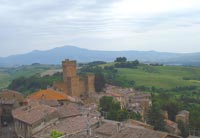 Proceno |
||
| Castello di Proceno |
|||
| The Castello di Proceno is a 12th century fortress built to protect the ancient hamlet. The surrounding region is full of Etruscan, Medieval and Renaissance monuments that testify to the presence of ancient civilizations. The castle is a rare example of a medieval fortification surviving in its original state. Its pentagonal base incorporates a main tower and two secondary towers interconnected by walkways and a drawbridge. The complex includes a fort that is attached to one side of the castle by the town's defensive walls. |
|||
Torre Alfina |
|||
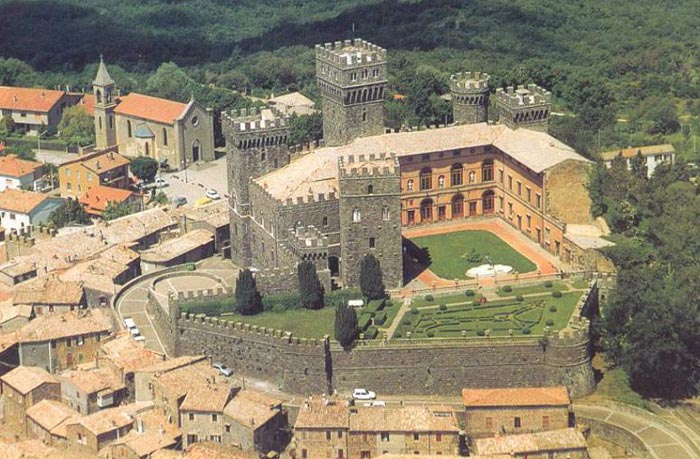 |
|||
Castello di Torre Alfina and garden |
|||
| Torre Alfina is a medieval picturesque village in the Acquapendente community. The village rose in the Early Middle Ages around an ancient turret placed on the top of the Alfina plateau. The history of Torre Alfina coincides with the history of its castle. Torre Alfina is built around a castle that once belonged to the Monaldeschi and Bourbon del Monte families until it was purchased by Edoardo Cahen in 1880. The central tower (Cassero) was built by the Lombard king Desiderius. With the expansion of the village, the original fortress was fortified with a second ring of walls made of bastions, walls of houses and many gateways. Two of these gates disappeared with the renovation works of Marquis Cahen, while Porta Vecchia is still visible. The palace was built near the tower; and was the home to the successive Lords. The Monaldeschi Palace was renovated by Edward Cahen. Various parts of the village were involved and completely transformed, such as the area that faces the entrance ramp to the castle or the one overlooking Piazza Sant'Angelo, which is occupied by a roof garden and by the entrance staircase. This colossal work, which carried on until the end of the 1920’s, was assigned to the architect Giuseppe Partini from Siena. Edward Cahen never managed to see the castle finished but he wanted to be buried, in a mausoleum built in the same neo-Gothic style as the castle, covered in basalt and refined with travertine that was in the forest-garden, that he had made accessible with paths constructed among the rocks, of the Sasseto. [read more] Rodolfo Teofilo, Edward's son, completed this work by furnishing the castle with great refinement and style and by creating a large garden above the forest. This dream was interrupted by the advent of Nazism, racial laws and then by the war. In fact the castle first became the headquarters of the Germans and then was plundered. The marquis fled and died in Paris, leaving everything to Urbano Papilloud, the butler, who lived sporadically in Torre Alfina and finally moved to Geneva with his wife. Torre Alfina itself is a small village, with little more than 450 inhabitants and besides the majestic beauty of its legendary castle, it offers several excursionists itineraries like the mountain-bike trails Allerona – Parco delle Selva di Meana in Umbria or San Casciano Bagni – Val d’Orcia in Tuscany. The Castle of the frazione Trevinano is known from the 12th century. |
|
||
| Allerona is a picturesque hill town in the mountains 19 km northwest of Orvieto. Remains of the feudal castle of Allerona include the ruins of the old walls, the two gates known as del Sole and della luna. Architectural monuments are few: ruins of a 12c castle, the 15c church of S. Maria dell' Acqua; although just outside the town proper, there are remains of a Roman aqueduct. Villalba and the Selva di Meana, bordering with Tuscany, are the two most interesting tourist areas. The former has a well-equipped public park while the latter has the state-owned park with Villa Cahen, in Art Nouveau style, and the hidden jewel in the center of the Park. In the marvellous gardens you can find various and rare arboreal and herbaceous species. [read more] |
|||
| Selva di Meana Park – Allerona | |||
| Part of the Mountain Community of Mount Peglia, it stretches for 2,500 hectares. The vegetation is rich and includes, as well as woods and Mediterranean bush, several species of wild orchids. The Villalba park and Villa Cahen are located here. | |||
The Monte Rufeno Natural Reserve, established in 1983, is part of the protected areas system of Lazio. It covers a surface of 2.892 hectares in, at the border with Umbria and Tuscany. |
|||
| Il Sentiero dei Briganti Il Sentiero Natura del Fiore Sentiero escursionistico "La Scialimata" Sentiero escursionistico "Monte Rufeno" Sentiero escursionistico "Acquachiara" Sentiero escursionistico equestre "La Fonte" Sentiero escursionistico "Fossatello" Sentiero ciclabile Coppi Sentiero ciclabile Girardengo Sentiero ciclabile Bartali |
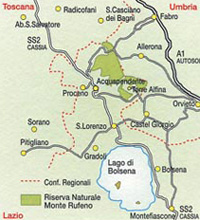 |
||
| www.parks.it | Itineraries |
|||
| The Selva di Meana Park is adjacent to the Natural Reserve of Mount Rufero of which it repeats the environmental characteristics. The poorly inhabited territory is crossed by many marked and scheduled nature walks. Among these, the Anello di Allerona (Allerona Ring) which crosses the entire territory of the park. |
|||
| Parco di Monte Peglia e Selva di Meana (S.T.I.N.A) - Full screen interactive map | www.parks.it |
|||
The Selva of Meana Trail |
|||
| Villalba Trail Departure: Villalba Duration: 5 hour/s Difficulty Level: E - Hiking (level) Length: 13.4 km Map full screen |
|||
| Elmo Trail Departure: S. Faustino Duration: 7 hour/s 30 minutes Difficulty Level: E - Hiking (level) Length: 17.6 km Map full screen |
|||
| Trail of the 'Devil's Lairs' Departure: Parrano Duration: 4 hour/s 30 minutes Difficulty Level: EEA - For expert hikers with equipment Length: 9.0 km Map full screen |
|||
| The Great Trail of Orvieto (GAO) Departure: Orvieto Duration: 11 days Difficulty Level: E - Hiking (level) Length: 168.2 km Map full screen |
|||
| Carta dei sentieri Regione dell'Umbria e S.T.I.N.A, Editore: Monte Meru Editrice, 2008, Scala: 1:50.000 |
|||
Torre Alfina and Trevinano are frazioni of Acquapendente. Communities of the Province Viterbo | Acquapendente · Arlena di Castro · Bagnoregio · Barbarano Romano · Bassano Romano · Bassano in Teverina · Blera · Bolsena · Bomarzo · Calcata · Canepina · Canino · Capodimonte · Capranica · Caprarola · Carbognano · Castel Sant'Elia · Castiglione in Teverina · Celleno · Cellere · Civita Castellana · Civitella d'Agliano · Corchiano · Fabrica di Roma · Faleria · Farnese · Gallese · Gradoli · Graffignano · Grotte di Castro · Ischia di Castro · Latera · Lubriano · Marta · Montalto di Castro · Monte Romano · Montefiascone · Monterosi · Nepi · Onano · Oriolo Romano · Orte · Piansano · Proceno · Ronciglione · San Lorenzo Nuovo · Soriano nel Cimino · Sutri · Tarquinia · Tessennano · Tuscania · Valentano · Vallerano · Vasanello · Vejano · Vetralla · Vignanello · Villa San Giovanni in Tuscia · Viterbo · Vitorchiano |
||
Enlarge map Aquapendente |
||
Acquapendente rises on the Francigena way, an important road that allowed the small town to grow up. During XVIth century in Acquependente were built the most beautiful domes and palaces on the main road and on the square, such as Fidi Palace, Viscontini Palace, the Bishop Palace. There are three intereting three itineraries: a Medieval one, another of the Renaissance, and the one of Quintaluna.
|
||
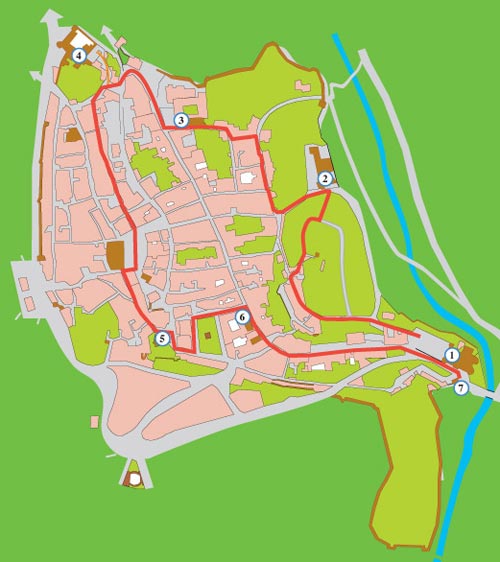 |
1) Cripta S. Sepolcro
2) Chiesa S. Giovanni 3) Chiesa S. Francesco 4) Monastero S. Chiara 5) Chiesa S. Vittoria 6) Chiesa S. Agostino 7) Torre Julia De Jacopo | |
|
||
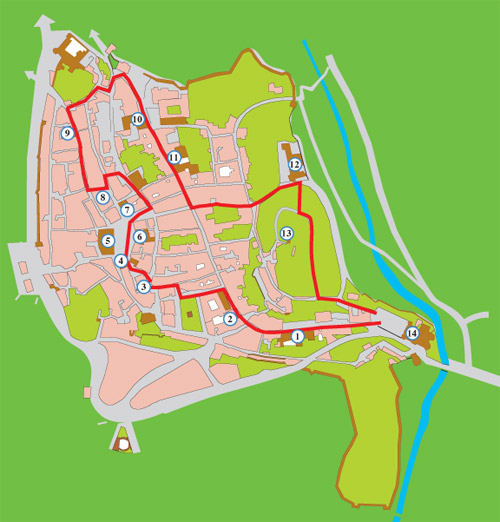 |
1) Palazzo Vescovile 2) Chiesa S. Caterina3) Fonte del Rigombo 4) Palazzo Benci-Caterini 5) Palazzo Comunale 6) Palazzo Piccioni 7) Palazzo Costantini 8) Fonte della Rugarella 9) Chiesa S. Lorenzo 10) Ospedale Civile 11) Palazzo Viscontini 12) Casa di Riposo 13) Torre del Barbarossa 14) Cattedrale S. Sepolcro |
|
The municipalities of the towns of Acquapendente and Bolsena (located at the border between Latium and Tuscany) have restored (for pedestrians only) the old Via Cassia where it diverges from the current one. Via Francigena walks have become very popular among the residents and the many foreigners who live in the area.
|
||
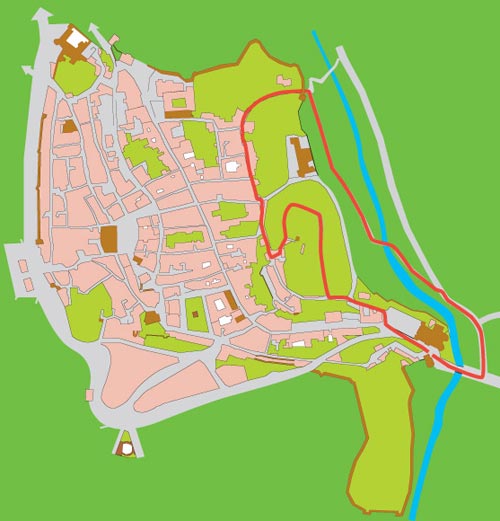 |
Quintaluna Beginning from the Julia de Jacopo Tower, going along the Quintaluna torrent, walking the S. Leonardo-Acquaviva road, it is possible to enjoy completely unique landscapes and alleys going through the ancient part of the town. The torrent is called Quintaluna because of two reasons: the first one is related to the time employed from pilgrims to reach Rome from Acquapendente (5 days/nights) by feet; the other reason is coming from a deformation of the latin “gens quintilian”. |
|
Festa dei Pugnaloni |
||
The festival takes place between Saturday and Sunday. It is a festival of pugnaloni: beautiful mosaics made out of petals, flowers and leaves, a folklore element of the festival of the Madonna del Fiore (Madonna of the Flower). The word 'Pugnalone' resembles that of 'Pugnale', meaning a 'large dagger', conjuring up an image of a fight of some sort. The origin of the festival can in fact be traced back to 1166, when the Italian States were prey to different invaders. At the time the northern part of Lazio, where Rome lies, was being contested between the Papal power and that of the Emperor Federico Barbarossa. Under the latter's rule, conditions were extremely bad and in the town of Acquapendente the peasants were feeling particularly oppressed. |
||
|
||||
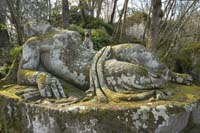 |
||||
Spoleto, duomo |
Castiglioncello Bandini |
Il parco dei Mostri in Bomarzo |
||
Orvieto |
Castell'Azarra |
Pisa |
||
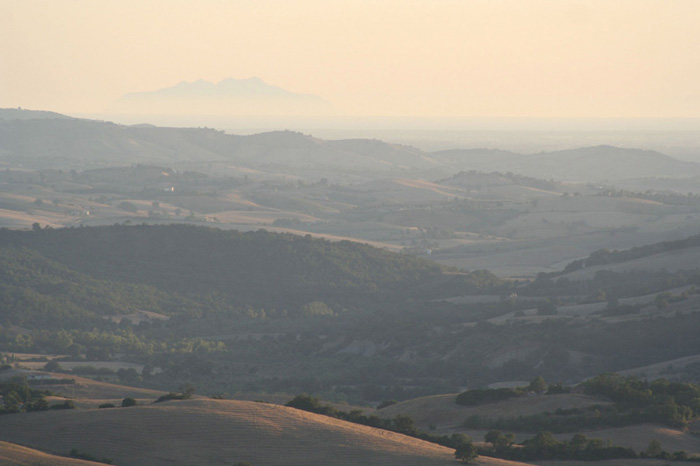 |
||||
Podere Santa Pia, situated in a particularly scenic valley, which overlooks on the hills around Cinigiano,
up to the Maremma seashore and Montecristo |
||||

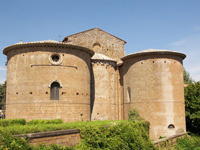 Cathedral of San Sepolcro, abside
Cathedral of San Sepolcro, abside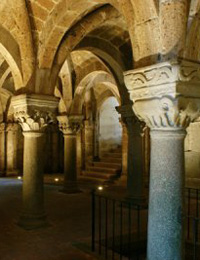 Collegiata del Santo Sepolcro, crypt
Collegiata del Santo Sepolcro, crypt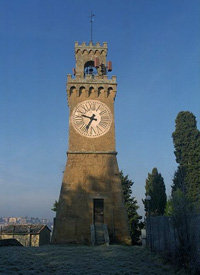 The clock tower, also known as
The clock tower, also known as 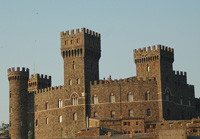 Torre Alfina
Torre Alfina